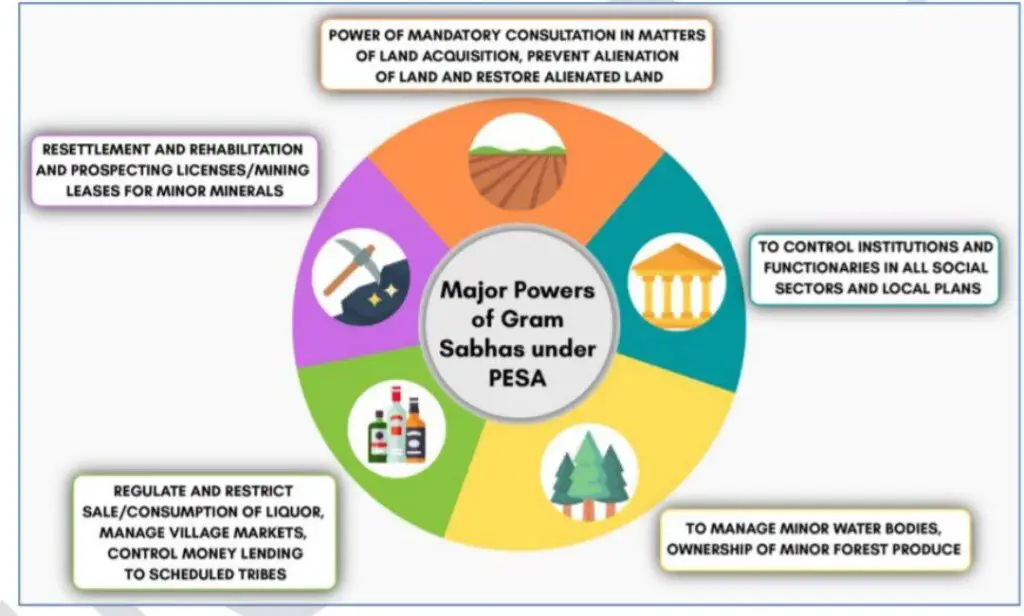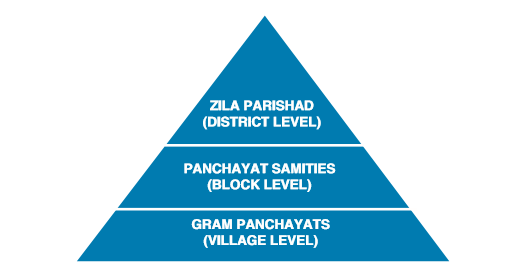When the panchayat raj is established, public opinion will do what violence can never do.
Mahatma Gandhi
Empowering Atmanirbhar Panchayats for Sustainable Development
The Ministry of Panchayati Raj organized a day-long National Webinar with the theme ‘Atmanirbhar Panchayats – Role of Technology, Entrepreneurship, and Harnessing Energy in Achieving Self-reliance for Sustainable Development.’ This initiative aligns with the country’s celebration of 75 years of Independence, known as ‘Azadi Ka Amrit Mahotsav.’ It is in line with the Prime Minister’s vision of ‘Atmanirbhar Bharat’ or self-reliant India.

Empowering Rural Economic Development:
- The concept of Atmanirbhar Panchayats revolves around fostering economic development in rural areas through the integration of Rural Technology and Entrepreneurship.
- Its primary objective is to equip Panchayats with knowledge of cost-effective, tested, and practical new technologies. The goal is to ensure that the benefits of these technologies reach even the remotest rural areas. By doing so, Panchayats can evolve into Economic Growth Centres and Demand Centres, contributing significantly to the local economy.
- Panchayats, in this context, can act as intermediaries between academic institutions like IIT’s Rural Technology Action Group (RuTAG) and the rural communities. This bridges the gap between advanced technology and grassroots needs.
Key Points
Panchayati Raj Institutions (PRIs):
- Panchayati Raj Institutions (PRIs) constitute a system of rural local self-government in India.
- The 73rd Constitutional Amendment Act of 1992 constitutionalized PRIs to establish democracy at the grassroots level and entrust them with the task of rural development.
- Part IX of the Indian Constitution, titled “The Panchayats,” contains Articles 243 to 243O.
- PRIs follow a three-tier structure: village-level Panchayats, intermediate block/taluk/mandal, and district-level Panchayats. However, States with a population below 20 lakhs are exceptions to this rule (Article 243B).
- Reservations are mandated for Scheduled Castes (SCs), Scheduled Tribes (STs), and women across various PRI levels.
- The election process for PRIs is independent of the state government’s discretion, overseen by an Independent Election Commission in each State (Article 243K).
- State Finance Commissions have been established in each state to determine the principles ensuring adequate financial resources for Panchayats and municipalities (Article 243I).
- The Act classifies provisions into compulsory and voluntary categories. While compulsory provisions must be incorporated into state laws, including the formation of new Panchayati Raj systems, voluntary provisions are left to the state government’s discretion.
- This Act is a pivotal step in establishing democratic institutions at the grassroots level in the country, transitioning from representative democracy to participatory democracy.
Introduction to Panchayati Raj


Panchayati Raj, which translates to rural local self-governance, is a vital component of India’s democratic structure. It was constitutionalized through the 73rd Constitutional Amendment Act (CAA) of 1992. Here’s a glimpse into its evolution:
1. Balwant Raj Mehta Committee
- This committee laid the foundation for democratic decentralization and recommended the establishment of Panchayati Raj.
- In 1959, Rajasthan became the first state to implement Panchayati Raj, and Andhra Pradesh soon followed.
2. Ashok Mehta Committee
- It suggested creating a three-tier Panchayati Raj system, which was later simplified to a two-tier system: Zila Parishad at the district level and Mandal Panchayat below it.
- Emphasized the district as the primary point for decentralization.
- Advocated for Panchayats to have essential powers of taxation and financial management.
- Recommended Nyaya Panchayats as separate bodies presided over by qualified judges.
- Proposed the appointment of a Minister for Panchayati Raj and made the state responsible for this ministry.
- Reserved seats for SC/ST based on population.
- However, due to the collapse of the Janata government, these recommendations could not be implemented.
3. GVK Rao Committee
4. L M Singhvi Committee
5. Thungon Committee
6. Gadgil Committee
- Constituted in 1988, the Gadgil Committee aimed to enhance the effectiveness of Panchayati Raj institutions.
- It bestowed constitutional status on the Panchayati Raj.
- Advocated a three-tier system – Village, block, and district levels.
- Introduced a fixed five-year term for directly elected members with reservations for SC/ST/women.
- Recommended the establishment of State Finance Commissions and State Election Commissions for efficient management.
The 73rd Constitutional Amendment Act, 1992
- The 73rd CAA added Part 9 to the Constitution, outlining Panchayats (Articles 243 to 243 O).
- It marked a significant milestone in the evolution of grassroots democracy.
- Key features of the amendment include provisions for Gram Sabha, a three-tier system, elections for members and chairpersons, seat reservations, fixed Panchayat durations, disqualification criteria, State Election Commissions, and Finance Commissions for audits and accounts.
The Panchayats (Extensions to the Scheduled Areas) Act, 1996 (PESA Act, 1996)
- The PESA Act aims to extend the provisions of Part 9 to scheduled areas with specific modifications.
- It strives to empower tribal communities for self-rule, preserve their traditions, and ensure democratic participation in village governance.
Challenges and Reasons for Ineffectiveness
- Inadequate Devolution: The delegation of powers and responsibilities to Panchayats is often insufficient.
- Bureaucratic Control: Excessive control by bureaucracy limits Panchayats’ autonomy.
- Funding Restrictions: Funds are tied to specific projects, reducing Panchayats’ flexibility.
- Dependency on Government Funding: An overwhelming reliance on government funds restricts financial independence.
- Gram Sabha Status: The Gram Sabha, intended for public participation, is only sometimes effectively engaged.
- Parallel Bodies: The creation of parallel governance structures can lead to confusion.
- Poor Infrastructure: Inadequate infrastructure hampers the functioning of Panchayats.
Efforts are required to address these challenges and enhance the effectiveness of Panchayati Raj institutions, thereby ensuring the success of grassroots democracy in India.
National Panchayat Awards: Celebrating Local Excellence

The President’s Honors:
- Recently, the President of India presided over the presentation of the National Panchayat Awards and inaugurated the National Conference on Incentivization of Panchayats in New Delhi.
- The Union Ministry of Panchayati Raj is observing the National Panchayat Awards Week from April 17th to April 21st, 2023. This celebration is part of the Azadi Ka Amrit Mahotsav (AKAM) 2.0 initiative, leading up to National Panchayati Raj Day on April 24th, 2023.
Understanding National Panchayat Awards:
- These awards recognize the outstanding performance of Panchayats in achieving Sustainable Development Goals (SDGs).
- The tradition of these annual awards began in 2011 to honour the remarkable contributions of Panchayats across India.
- In the 2023 edition of the National Panchayat Awards, several categories of recognition were included:
- Deen Dayal Upadhyay Panchayat Satat Vikas Puraskar (DDUPSVP): This award acknowledges exceptional performance in specific Individual Local Sustainable Development Goals (LSDG) themes.
- Nanaji Deshmukh Sarvottam Panchayat Satat Vikas Puraskar (NDSPSVP): Awarded for exceptional aggregate performance across all nine LSDG themes and in the context of green initiatives.
- Gram Urja Swaraj Vishesh Panchayat Puraskar: Recognizes Panchayats making strides in energy self-sufficiency at the grassroots level.
- Carbon Neutral Vishesh Panchayat Puraskar: Celebrates Panchayats significantly contributing to carbon neutrality.
- During the event, the Union Minister of Rural Development launched the GS NIRNAY (Gram Sabha – Navigate, Innovate, and Resolve Panchayat Decisions) mobile application.
- This innovative app facilitates easy access to crucial information discussed during a Gram Sabha, promoting transparency and efficiency in Panchayats’ functions. These local governance bodies are instrumental in decentralized participatory democracy and grassroots development.
The National Panchayat Awards are a testament to the significant role that Panchayats play in fostering sustainable development and realizing the goals of a self-reliant and vibrant India.
M.C.Q.
Q. What is Gram Sabha ?
Answer :- The Gram Sabha, comprising all the adult members of an Indian village, is the foundational institution within the framework of the Panchayati Raj system, India’s local governance structure. It bears the crucial responsibility of formulating and executing village-level development initiatives.
Q. What is Gram Panchayat ?
Answer :- The Gram Panchayat, the most fundamental level of India’s local self-government, is composed of elected representatives representing either an individual village or a cluster of villages. This body is entrusted with the governance of the village and the execution of developmental initiatives. The Gram Panchayat consists of a Sarpanch (the leader) and several Panchs (members).
Q. What is Panchayati Raj ?
Answer :- Panchayati Raj Institutions (PRIs) constitute a system of rural local self-government in India.
Q. What is local self government ?
Answer :- Local self-government is a governance framework where the inhabitants of a particular area possess the authority to self-administer. This system constitutes a decentralized form of governance, in which the central government entrusts specific powers to local governing bodies.
1. Municipalities: Municipalities serve as local governing bodies entrusted with the provision of urban services like water, sanitation, and waste management.
2. Panchayats: Panchayats function as local governing bodies dedicated to delivering services such as agriculture, education, and healthcare in rural regions.
3. Special Purpose Districts: Special purpose districts are established as local governing entities with the sole purpose of offering specialized services, such as transportation or water resource management.
